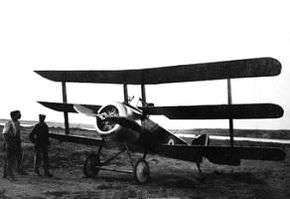Alcock Scout
| Alcock Scout | |
|---|---|
 | |
| Role | Fighter |
| National origin | United Kingdom |
| Designer | Flight Lieutenant John Alcock |
| First flight | 15 October 1917 |
| Retired | 1918 |
| Number built | 1 |
|
| |

The Alcock Scout, aka A.1 and Sopwith Mouse, was a curious "one-off" experimental fighter biplane flown briefly during World War I. It was assembled by Flight Lieutenant John Alcock at Moudros, a Royal Naval Air Service base in the Aegean Sea. Alcock took the forward fuselage and lower wings of a Sopwith Triplane, the upper wings of a Sopwith Pup and the tailplane and elevators of a Sopwith Camel, and married them to a rear fuselage and vertical tail surface of original design (presumably by Alcock himself). It was powered by a 110 hp Clerget 9Z engine, and carried a .303 Vickers machine gun.
Affectionally referred to as the 'Sopwith Mouse' by Alcock and his fellow designers, Alcock never flew it himself, but squadron-mate FSL Norman Starbuck made a few flights in it, the first on 15 October 1917. However, it crashed in early 1918, was written off and never flew again.
Specifications (approximate)
Data from War Planes of the First World War: Volume One Fighters[1][nb 1]
General characteristics
- Crew: 1
- Length: 19 ft 1 in (5.82 m)
- Wingspan: 24 ft 3 in (7.39 m)
- Height: 7 ft 9 in (2.36 m)
- Powerplant: 1 × Clerget 9Z nine-cylinder rotary engine, 110 hp (84 kW)
Armament
- 1 x .303 Vickers machine gun
Notes
Citations
References
- Bruce, J.M. (1965). War Planes of the First World War: Volume One Fighters. London: Macdonald.
- Taylor, Michael J. H. (1989). Jane's Encyclopedia of Aviation. London: Studio Editions. p. 56.
- The Complete Book of Fighters. Godalming, UK: Salamander Books. p. 302.